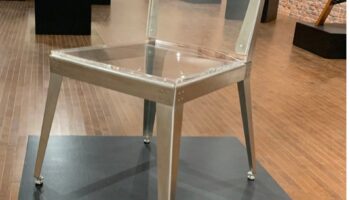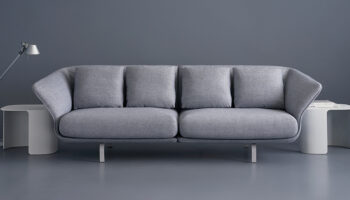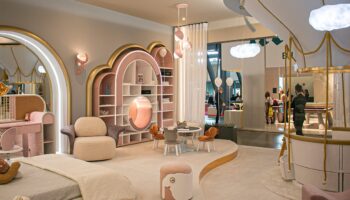Baobab
The press material on Barcelona Industrial Designer Christian Vivanco‘s new loveseat makes it sound as if “Baobab” were as mundane and accessible a notion as “socks”: “as its name suggests, this piece is evocative of a giant Baobab, welcoming you with its protective shell.” Now, maybe this is a reflection of a personal botanical failing, or maybe it’s a product of my North Amero-Centric Western education (yes, as it turns out), but I must admit that I’ve never heard of a “Baobab,” and I consider myself more worldly than most.
Baobab. Designed by Christian Vivanco.
Even so, the onomatopoetic buzz of the word set me to wondering: is it a mythical beast of African lore? Analogous to an ogre or giant? Could it be some protective contraption of antiquity? A niche hollowed out of a cave? A spacious assemblage of tree roots and bark? Leave it to Wikipedia to set me to rights: a genus of eight species of trees native to Madagascar, Africa, and Australia, “the Baobab is regionally revered for its formidable water storage capacity, its nutritious and medicinally-viable leaves, and the healthful pulp of its oversized fruit. Also known as ‘sour gourd’ or ‘monkey’s bread,’ this delicacy is quite nutritious, possibly having more vitamin C than oranges and exceeding the calcium content of cow’s milk.” Ah, so this is my favorite kind of product-naming device, an evocative (if potentially arcane) attempt at metaphorical resonance for shelter, protectiveness, functionality, and sustenance. In other words, as Ren©e Zellweger might say, “you had me at monkey’s bread.”

Baobab joins the ranks of such 3rings favorites as the Globus Mobile Office Pod, the Yu Chair, and the Egg Chair-all pieces that sing the praises of extruded plastic, that incorporate the intrinsically shell-like quality of the material to shape and sculpt upholstered foam. Like its forebears, Baobab has an holistic quality, inviting submission to the vulnerabilities of authentic relaxation, yet promising protection during said state. Vivanco captures this nicely, in his execution of the piece as well as his characterization of it: “Baobab is the result of an experiment on surfaces and rhythm, a continuous development of the value of mass and volume.” Another way of saying this is that the proportions of the sofa just look right, the relationship between structure and negative space creating a fluidity that invites real repose. In this respect, the reference to the protective and nutritive tree of the lower hemisphere has an additional meaning-organicism. Just like that fortuitously hollowed niche in the rock or that miraculously arranged carpet of foliage, Baobab seems as if it were custom-made for your very own bodily contours.




Leave a Reply